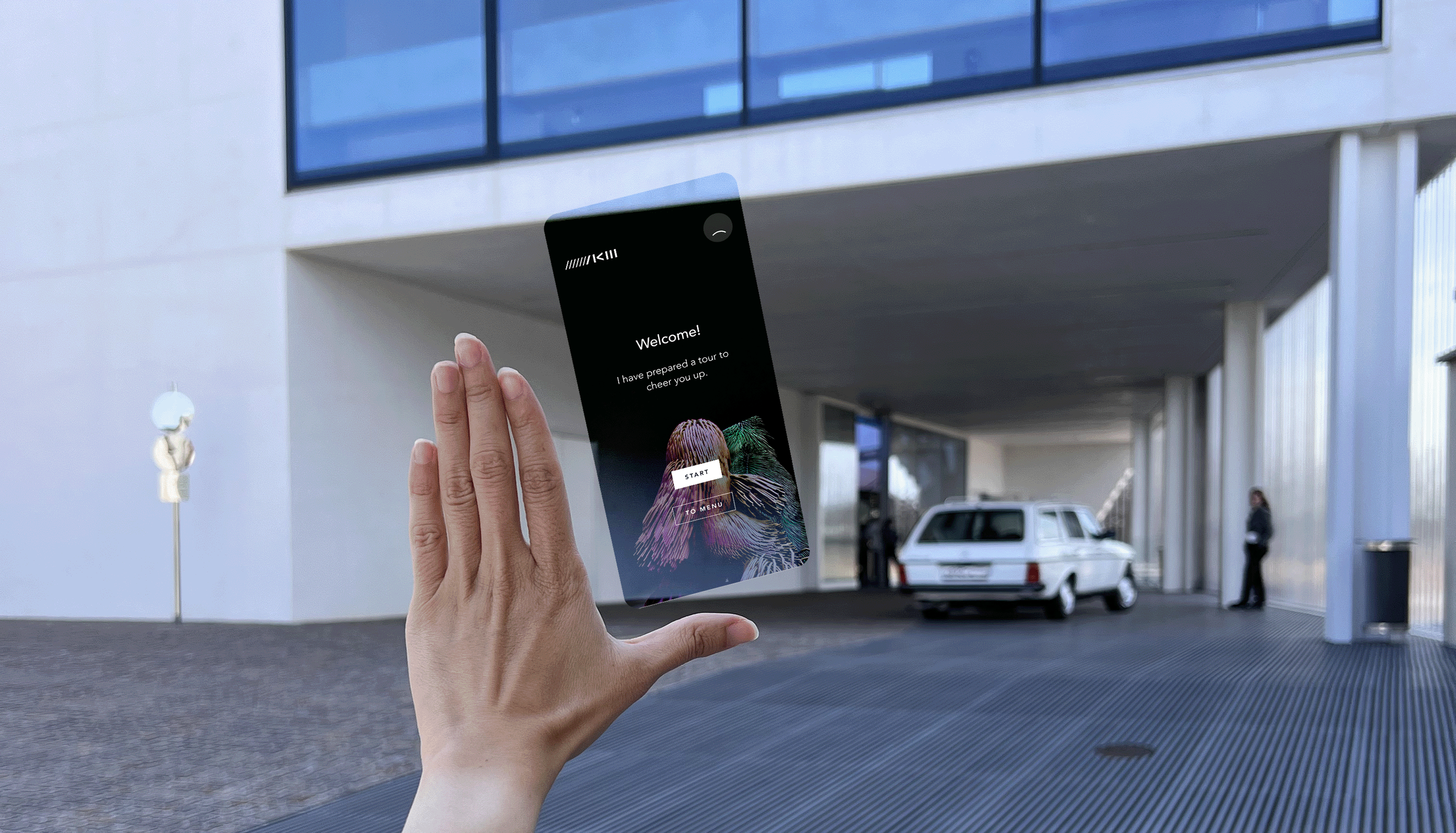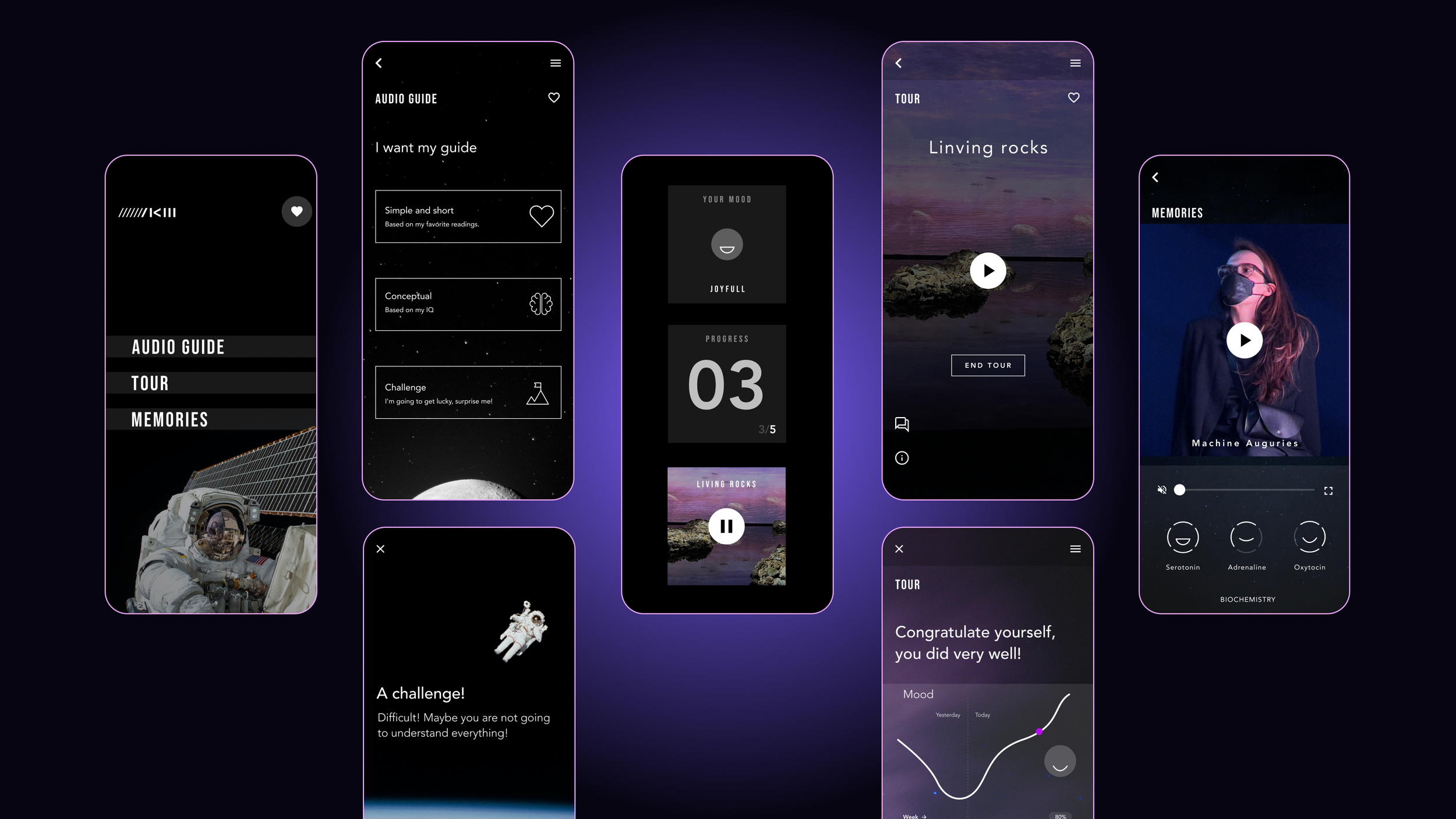
ZKM time.
Project
UI/UX Design
Speculative scenario
Digital product
My role
My roleUI/UX Designer
UX Researcher
Speculative Designer
Methodology
Speculative design
User-centered design (UCD)
Future scouting
Tools & software
Tools
User Journey
Affinity map
Personas
Future scouting canvas
Moodboard & design persona
Flow diagrams
Low-, mid-, high-wireframes
Software
Figma
Mural
Google tools
ZKM time.
It is a speculative scenario and product that shows how the museum can evolve within the biotechnological revolution.

Imagine.
Imagine a time in the future, where humans go to a spa for the mind. A place where they can calm the mind, have a mindful moment, recharge energy and learn. This is how a digital art museum becomes a spa for the mind.
I developed a speculative scenario, that shows the evolution of a museum within a biotechnological revolution, using specialized biometric sensors. It intends to meet the need for mental hygiene within a desolate context for humanity due to the effects of climate change.
This is a change of the paradigm of the museum: the museum not only safeguards culture, it will also care for the welfare of its audience.
“Speculative design is a discipline that seeks to design products of the future as a way of understanding the social, cultural and ethical implications of the use of technology.”
— J.Paul Neely
Speculative design is used to address wicked problems, by their nature considered difficult, such as the use of personal data for specific uses. The data from people to create museum experiences has been the central piece in the creation of the speculative scenario.
Signal.
Signals are any phenomenon that can cause a change. My signal has been the concept of a biometric sensor that "converts biological processes into electronic information that computers can store and analyse". All within a biotechnological revolution proposed by the historian Yuval Noah Harari.
Scenario.
Since the beginning of the pandemic we have been living in a time of great uncertainty. For many it has been a change on many levels. Our smartphones and computers keep sending notifications all the time. Everything and everyone demands our time and attention. At times it is very stressful.
In my vision of the future, this condition has not changed positively, that is why there are spaces dedicated to relax the mind, in addition to having an algorithm that takes care of our cognitive performance, to save that energy and potential for more useful activities.
This explains why a museum evolves to offer a space for mental hygiene and intellectual development. A spa for the mind.
For the creation of the scenario I used the future scouting methodology, which allows to create a product within the speculative design approach. It is a series of canvases that allows to develop gradually: the invention, the narrative, describes the user and context.
Product.
The result is a digital product that uses data from people's biochemistry to take care of people's mental and physical health by suggesting activities within the museum.
It is a tool that offers the museum's audience:
A mindful tour to balance biochemistry and reduce fatigue during a visit to the museum
Offers audio guides based on intellectual level and personality, so that people can understand the themes and pieces of the exhibition.
Finally, it shows a collection of the best moments taken by the museum's paparazzi (cameras and the museum’s robots), so that people always have access to the best ones to remember them.
The tool's algorithm uses data collected by biometric sensors, which the AI should work with to create a personalized museum experience.
Challenges & learnings
Speculative design shows visions of the future, some desired, some not, but they help us define the future we want to build. It also forces us to think about how we might react in challenging or unimaginable contexts and time.
For those who have read Harari, this vision of the future might seem optimistic; and that is my intention, to show an optimistic and purposeful side of technological progress.
Learnings
Explore
Some UX or strategic design tools were not suitable for the project, because they are intended to solve problems and speculative design has a different purpose, as a result, the search and creation of tools have been very useful for the success of the project. Tools like the book Future Scouting by Damien Lutz and the creation of canvases like the Design Persona based on the book Design for Emotions by Aarron Walter.
React and improvise
During the user tests, I understood that the regular usability test dynamics of performing a task doesn’t work in my speculative scenario. It turned out to be better to do an interview where participants shared their imaginations of the future, while playing with a prototype. Once I realized this phenomenon, I let the conversation flow and some very good ideas emerged.
Good design is based on research
I know this is nothing new, but it's worth repeating again and again until we get tired of it (and do it in daily practice), because it defines the success of a product and its lifespan. Good design is based on research.
Conclusions
Before the beginning of 2020 it was difficult to imagine how a pandemic would affect the world. Now more than ever it can be shown that thinking about unimaginable scenarios could have positive effects. Thinking about such scenarios and creating products for the unimaginable will help to explore their impact before development. In this way we will design the future we want to live in.
The images below are some of the tools used during the development of the project. They are a sample of the designer's tools.
The image used as a banner is based on the photo by Gift Habeshaw and Hugo Jehanne on Unsplash, and the icons are from the noun project. 
















